The very first test of three electric cars with caravans
Denne artikkelen ble oppdatert for over ett år siden, og kan inneholde utdatert informasjon.

Three experienced BEV testers. Three powerful BEVs with caravans behind them. Three days on tour in some of the most scenic parts of Norway.
Some people tend to have strong prejudices towards battery electric vehicles (BEV) and trailers/caravans. They seem to believe a BEV is not able to tow as heavy loads as diesel cars, that the electric motor is not strong enough, or that the range will be ruined.
Our goal in this world-first test: To examine if these three BEVs can do the «camping job» in style.
And what an experience it was. Attractions like Dalsnibba, Geiranger, Ørnevegen, Trollstigen and the Atlantic Ocean Road in Averøy. 1.381 kilometres in just three days. We recommend spending more time than we did during this test…
It all started with a crazy idea. It was time to book a test of the upcoming Mercedes-Benz EQC 400, and the question arose: «Why not bring the Audi e-tron 55 quattro and Tesla Model X Long Range along as well, and do a grand camping trip»?
The test team consisted of BEV pioneer and longstanding board member (Norwegian EV Association) Øyvind Lunde, our jack of all trades and part-time bus driver Magne Storebø and me – as a test manager.
That was the easy part. Getting hold of caravans was a bit trickier.
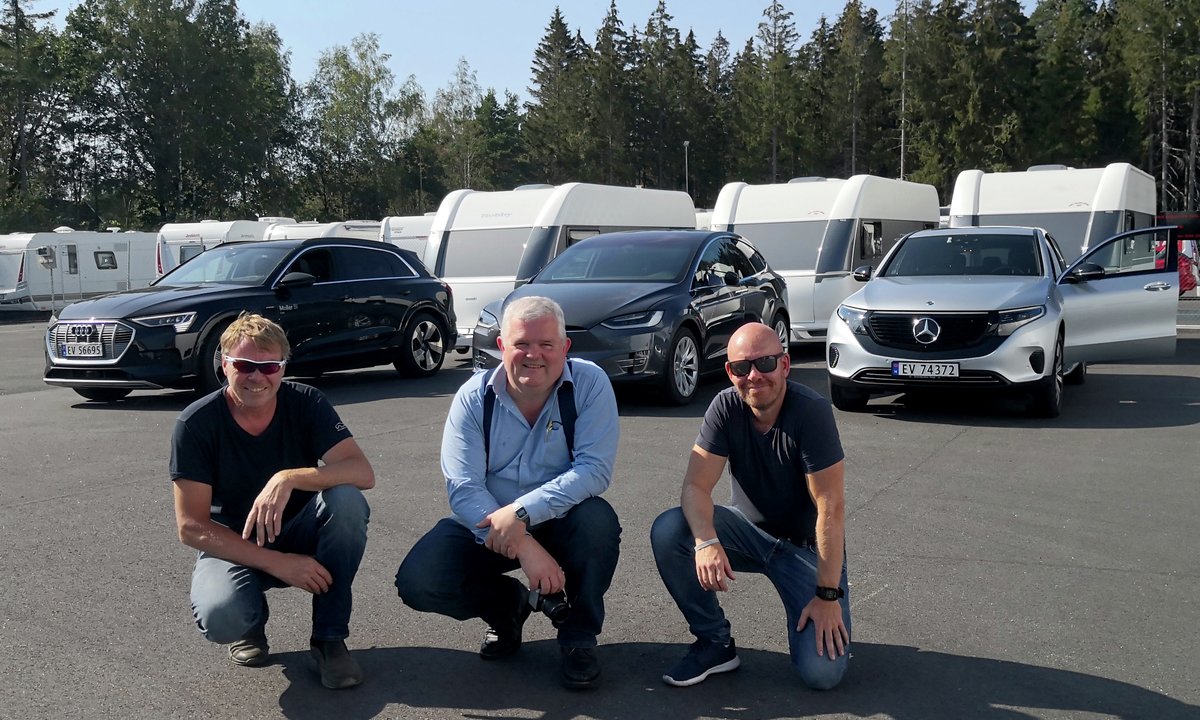 This test is mostly about how the three BEVs delivered as tractors, the relative difference in electric consumption versus normal driving and how charging infrastructure – or lack thereof – affects a trip like the one we did.
We did not spend much time discussing trim levels and options on the different cars. This was basically towing.
Watch video!
We utilized adaptive cruise control to a large extent during the test, especially on the long country road stretches. On the narrow and winding roads of Western Norway, we drove without any speed keeping assistance, off course.
Also, we did not utilize any Eco-driving programs, except the Audi, got to keep its «Efficiency» program as it lowers the car – and does not leave an egg under the throttle.
The temperatures inside the car ranged between 17-20 degrees Celsius, depending on outside temperatures, and air conditioning available throughout the trip. In short: With modern BEVs, we believe one should treat oneself to the desired level of comfort, even when towing heavy stuff.
To make the cars in the test close to 100 per cent comparable, the Audi should have had 20-inch wheels, just like the Tesla and the EQC. The only problem was: The car made available lacked a tow bar. We got hold of another e-tron on 21-inch wheels, which might have affected the range negatively.
After finishing the test, we are still wondering what difference one inch less would have made, although the roll circumference of the wheels was similar.
This test is mostly about how the three BEVs delivered as tractors, the relative difference in electric consumption versus normal driving and how charging infrastructure – or lack thereof – affects a trip like the one we did.
We did not spend much time discussing trim levels and options on the different cars. This was basically towing.
Watch video!
We utilized adaptive cruise control to a large extent during the test, especially on the long country road stretches. On the narrow and winding roads of Western Norway, we drove without any speed keeping assistance, off course.
Also, we did not utilize any Eco-driving programs, except the Audi, got to keep its «Efficiency» program as it lowers the car – and does not leave an egg under the throttle.
The temperatures inside the car ranged between 17-20 degrees Celsius, depending on outside temperatures, and air conditioning available throughout the trip. In short: With modern BEVs, we believe one should treat oneself to the desired level of comfort, even when towing heavy stuff.
To make the cars in the test close to 100 per cent comparable, the Audi should have had 20-inch wheels, just like the Tesla and the EQC. The only problem was: The car made available lacked a tow bar. We got hold of another e-tron on 21-inch wheels, which might have affected the range negatively.
After finishing the test, we are still wondering what difference one inch less would have made, although the roll circumference of the wheels was similar.

 To get a frame of reference for electricity consumption, we reset the trip odometers before driving from the Oslo to Østfold county, roughly 80 kilometres.
The average speed was low and «caravan suitable», at 70 km/h. The Tesla made do with 17.6 kWh/100 km, while the EQC demanded 18.9 and the e-tron 21.2.
We were all excited to see just what the Mercedes-Benz EQC 400 could accomplish during heavy towing. During the first test drive in May, the new BEV felt both heavy and inefficient. But, surprisingly, the consumption now was just barely higher with the caravan behind it than that wintery day in May.
Back on the outskirts of Oslo consumption was 29.3 kWh/100 km, with an average speed of 76 km/h. The increase was just 55 per cent. The Model X consumed 28.4 (61 per cent increase), while the e-tron showed 31.8 (50 per cent increase) – with experienced tester Øyvind Lunde behind the wheel.
To get a frame of reference for electricity consumption, we reset the trip odometers before driving from the Oslo to Østfold county, roughly 80 kilometres.
The average speed was low and «caravan suitable», at 70 km/h. The Tesla made do with 17.6 kWh/100 km, while the EQC demanded 18.9 and the e-tron 21.2.
We were all excited to see just what the Mercedes-Benz EQC 400 could accomplish during heavy towing. During the first test drive in May, the new BEV felt both heavy and inefficient. But, surprisingly, the consumption now was just barely higher with the caravan behind it than that wintery day in May.
Back on the outskirts of Oslo consumption was 29.3 kWh/100 km, with an average speed of 76 km/h. The increase was just 55 per cent. The Model X consumed 28.4 (61 per cent increase), while the e-tron showed 31.8 (50 per cent increase) – with experienced tester Øyvind Lunde behind the wheel.
 The rest of the day was spent familiarizing ourselves with both the BEVs and the caravans. After weighing the trailers, we got the necessary evidence: Caravans weighed in at 1.160 kilograms, a little bit less than fully equipped at 1.200. Maximum allowed weight for this Hobby caravan is 1.500 kilograms.
The Model X was the lightest among the BEVs, at 2.505 kilograms, with EQC as the runner-up at 2.568. The e-tron proved to weigh 2.660. The weight of the test drivers varied between 80 and a little more than 100 kilograms, but this difference was evened out by switching seats regularly.
We stayed overnight in a municipal parking lot, with some Mode 3 Type 2 slow charging, to be ready for the next day and some serious long-haul driving.
The rest of the day was spent familiarizing ourselves with both the BEVs and the caravans. After weighing the trailers, we got the necessary evidence: Caravans weighed in at 1.160 kilograms, a little bit less than fully equipped at 1.200. Maximum allowed weight for this Hobby caravan is 1.500 kilograms.
The Model X was the lightest among the BEVs, at 2.505 kilograms, with EQC as the runner-up at 2.568. The e-tron proved to weigh 2.660. The weight of the test drivers varied between 80 and a little more than 100 kilograms, but this difference was evened out by switching seats regularly.
We stayed overnight in a municipal parking lot, with some Mode 3 Type 2 slow charging, to be ready for the next day and some serious long-haul driving.
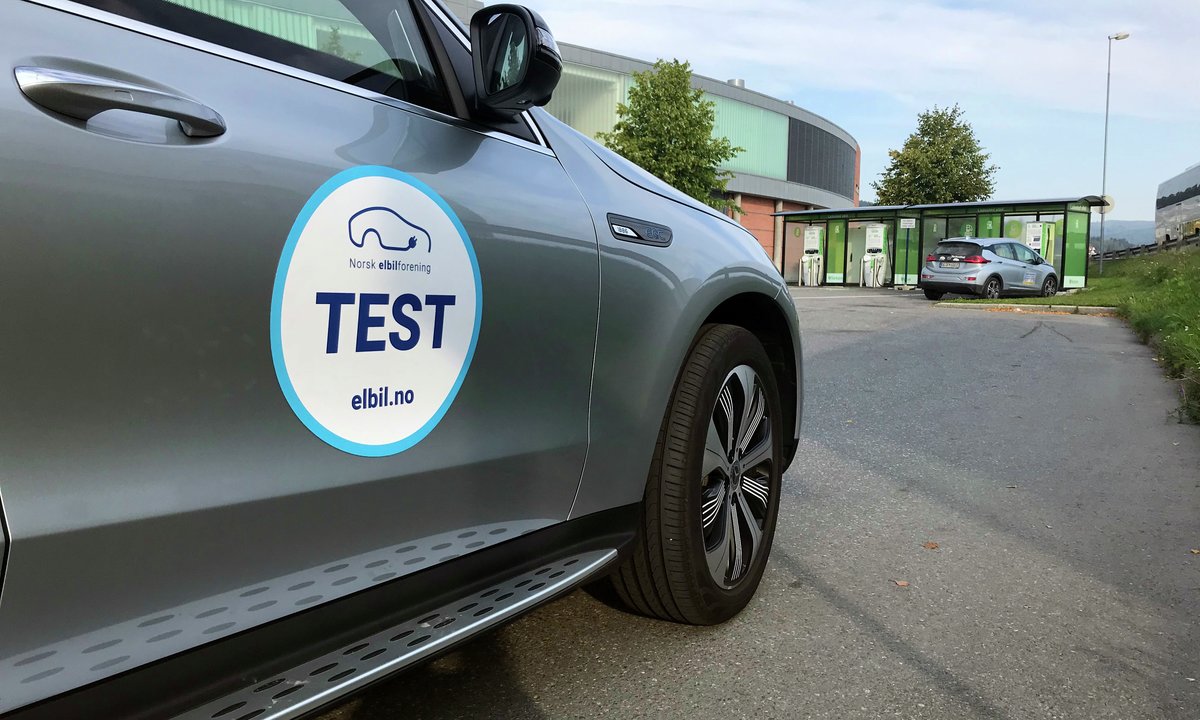 The Model X showed just what a tractor it is. No range anxiety whatsoever, and it arrived at the Supercharger in Vinstra with another estimated 115 kilometres left in the battery pack. With its estimated 98 kilowatt-hours (kWh) of stored energy, it only makes sense.
The EQC had no problems either, even though the estimated range was just 8 kilometres (from 80 kWh of usable capacity). To connect to the charger, we, rather unhandily, had to disconnect the caravan, as the EQC has its charge port on the right rear fender.
With the Audi we had to make a reasonable decision, even though it has 4 kWh more stored energy than the EQC. Arriving at Fåvång, with 35 kilometres more to reach Vinstra, the «guessometer» estimated 40 kilometres of range, which would be a bit of a stretch. The solution was a bit of 50 kW fast charging outside the local KIWI grocery store, and an extra 4.1 kWh – or estimated 13 kilometres of range.
The Audi charge port, which is located on the front left fender, was handy this time. It meant we had to disconnect the caravan just a few times during the test.
The Model X showed just what a tractor it is. No range anxiety whatsoever, and it arrived at the Supercharger in Vinstra with another estimated 115 kilometres left in the battery pack. With its estimated 98 kilowatt-hours (kWh) of stored energy, it only makes sense.
The EQC had no problems either, even though the estimated range was just 8 kilometres (from 80 kWh of usable capacity). To connect to the charger, we, rather unhandily, had to disconnect the caravan, as the EQC has its charge port on the right rear fender.
With the Audi we had to make a reasonable decision, even though it has 4 kWh more stored energy than the EQC. Arriving at Fåvång, with 35 kilometres more to reach Vinstra, the «guessometer» estimated 40 kilometres of range, which would be a bit of a stretch. The solution was a bit of 50 kW fast charging outside the local KIWI grocery store, and an extra 4.1 kWh – or estimated 13 kilometres of range.
The Audi charge port, which is located on the front left fender, was handy this time. It meant we had to disconnect the caravan just a few times during the test.
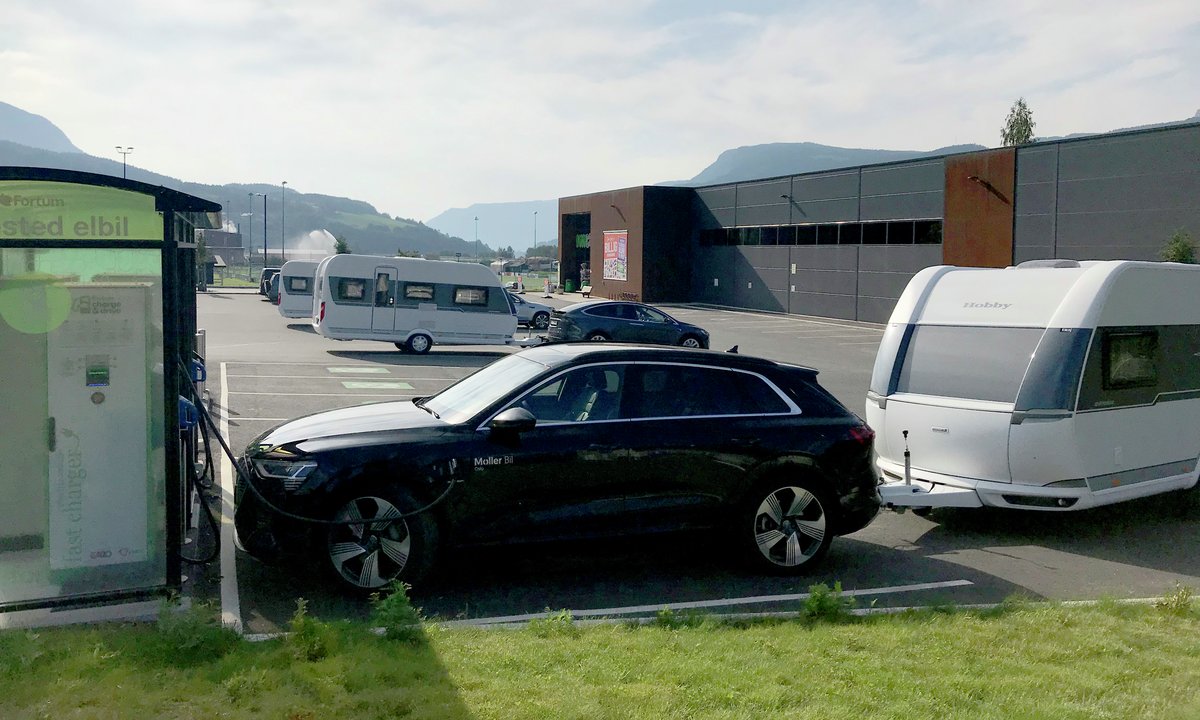 Finally arriving at Vinstra, the e-tron had some 11 estimated kilometres left (equals 4 per cent state of charge, SOC). This means we would likely have run out of energy without the extra fast charging break.
It is important to be aware of this experience: Nobody wants to be left with an empty battery on the roadside, especially on a camping trip. Better safe than sorry.
To get to 80 per cent SOC we had to spend roughly one and a half hour at the 50 kW DC charger (average power: 43,4 kW). The EQC needed a bit more time, with an average charging power around 40 kW.
Crowds of BEVs and caravans on tour is by far a daily sight, even in Norway, but we would have loved faster charging in this location. Aside from Tesla´s Supercharger, you will only find 50 kW chargers here, operated by CPOs Fortum Charge & Drive and Grønn Kontakt.
Finally arriving at Vinstra, the e-tron had some 11 estimated kilometres left (equals 4 per cent state of charge, SOC). This means we would likely have run out of energy without the extra fast charging break.
It is important to be aware of this experience: Nobody wants to be left with an empty battery on the roadside, especially on a camping trip. Better safe than sorry.
To get to 80 per cent SOC we had to spend roughly one and a half hour at the 50 kW DC charger (average power: 43,4 kW). The EQC needed a bit more time, with an average charging power around 40 kW.
Crowds of BEVs and caravans on tour is by far a daily sight, even in Norway, but we would have loved faster charging in this location. Aside from Tesla´s Supercharger, you will only find 50 kW chargers here, operated by CPOs Fortum Charge & Drive and Grønn Kontakt.
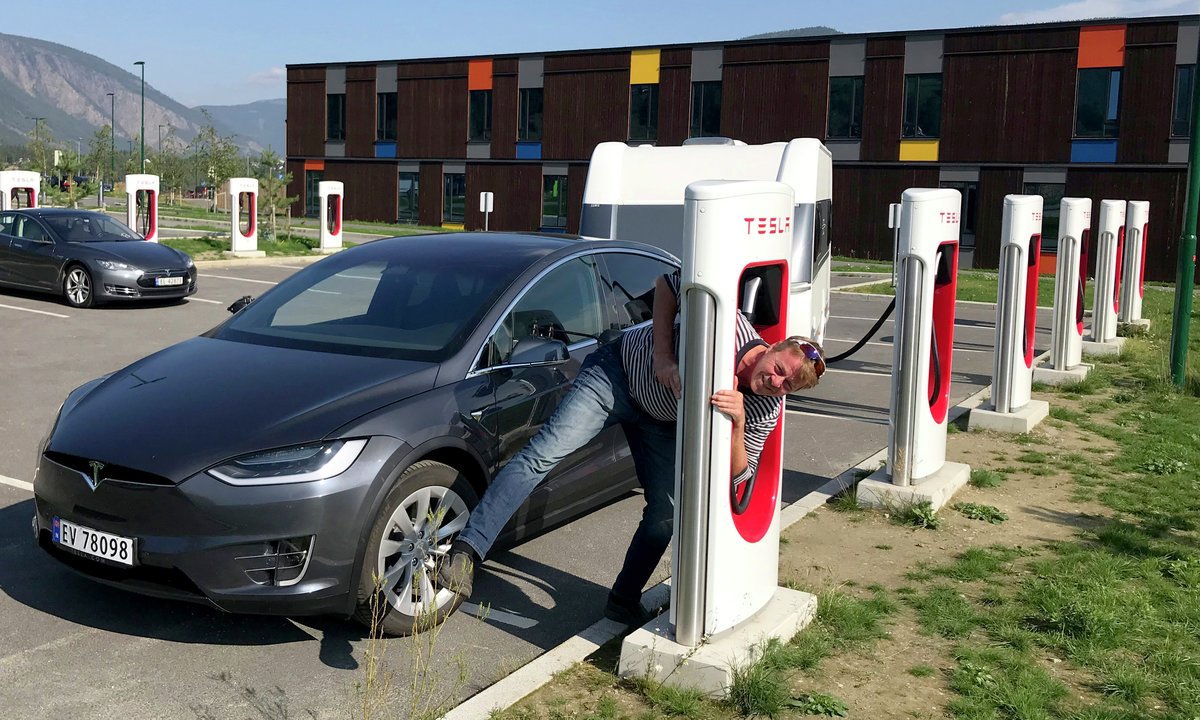 More high-power chargers (HPC) are highly desired – with or without caravans. And this nice and otherwise spacious location should most definitely have had a larger variety of plugs.
Luckily the Tesla Supercharger was not too busy, meaning we could occupy five stalls and avoid disconnecting. This is of course not recommended at «rush hour», and we would also have been unable to turn around with the caravan. We would have been left to back the trailer all the way.
Parallel parking by the fast charger, just like several Tesla Supercharger and IONITY locations have in Norway, is by far the best alternative.
More high-power chargers (HPC) are highly desired – with or without caravans. And this nice and otherwise spacious location should most definitely have had a larger variety of plugs.
Luckily the Tesla Supercharger was not too busy, meaning we could occupy five stalls and avoid disconnecting. This is of course not recommended at «rush hour», and we would also have been unable to turn around with the caravan. We would have been left to back the trailer all the way.
Parallel parking by the fast charger, just like several Tesla Supercharger and IONITY locations have in Norway, is by far the best alternative.
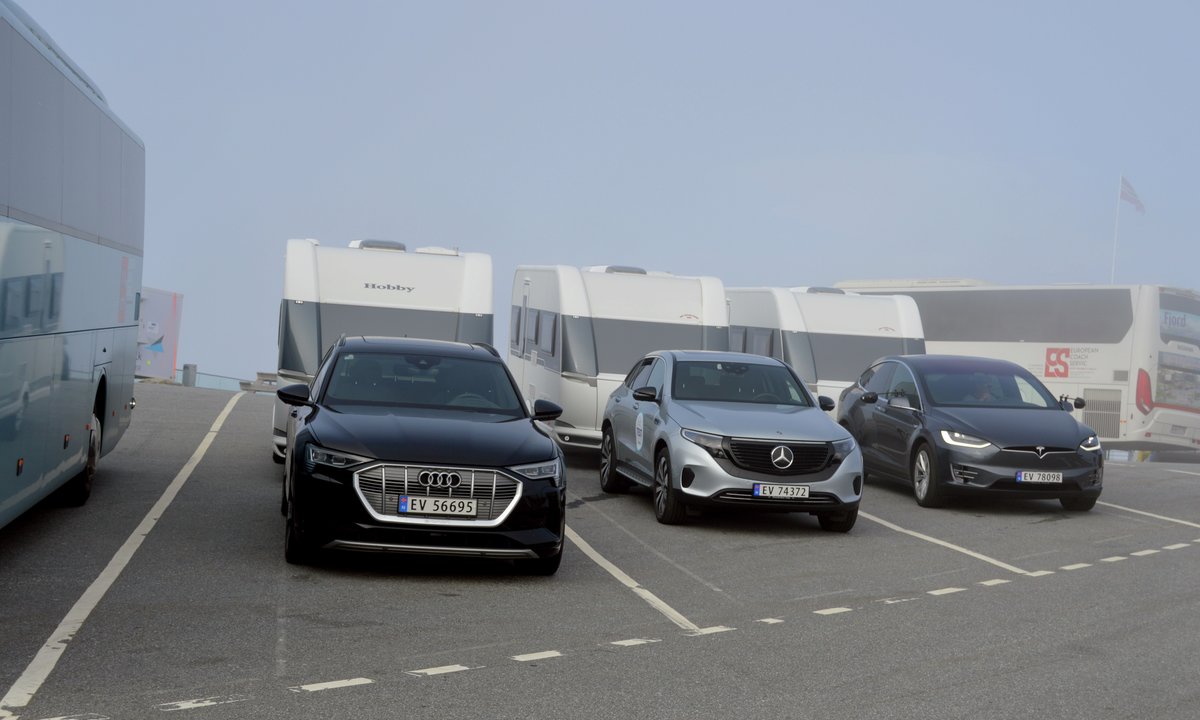 After a full charge, we left for famous viewpoint Dalsnibba. Then on to tourist hot spot Geiranger, and further on Ørnevegen to Eidsdal, and the first of three ferry stretches. Then we continued from «Strawberry Village» Valldal to Trollstigen and Åndalsnes. On this leg we introduced a specific test procedure, to see just how much «free fuel» you can get driving a BEV.
And, as we realized, even more, when towing a caravan. That happened even though the brakes of the caravans were in use more than we would have preferred, leading to less regeneration and «hot caravan wheels». This was both visible and «smellable» after the steepest descents underway.
We left Grotli with 100 per cent SOC on the two German cars, and 99 on the Model X. As the table shows, all the cars were able to regenerate as much electricity during the descent from Dalsnibba as consumed during the climb on Ørnevegen on the opposite side of Geiranger.
After a full charge, we left for famous viewpoint Dalsnibba. Then on to tourist hot spot Geiranger, and further on Ørnevegen to Eidsdal, and the first of three ferry stretches. Then we continued from «Strawberry Village» Valldal to Trollstigen and Åndalsnes. On this leg we introduced a specific test procedure, to see just how much «free fuel» you can get driving a BEV.
And, as we realized, even more, when towing a caravan. That happened even though the brakes of the caravans were in use more than we would have preferred, leading to less regeneration and «hot caravan wheels». This was both visible and «smellable» after the steepest descents underway.
We left Grotli with 100 per cent SOC on the two German cars, and 99 on the Model X. As the table shows, all the cars were able to regenerate as much electricity during the descent from Dalsnibba as consumed during the climb on Ørnevegen on the opposite side of Geiranger.
 Arriving at the ferry port of Eidsdal, we were back on the same SOC as when we left Dalsnibba. The stretch from Valldal to Alnesreset (highest above sea level before Trollstigen) meant climbing 850 meters. This resulted in a steep increase in electricity consumption for all three cars, while the Trollstigen descent regenerated enough energy for the trip to Åndalsnes.
The rest of the day, on better State Highways, showed very stable consumption numbers until we called it a day in Averøy, some 160 kilometres later.
Arriving at the ferry port of Eidsdal, we were back on the same SOC as when we left Dalsnibba. The stretch from Valldal to Alnesreset (highest above sea level before Trollstigen) meant climbing 850 meters. This resulted in a steep increase in electricity consumption for all three cars, while the Trollstigen descent regenerated enough energy for the trip to Åndalsnes.
The rest of the day, on better State Highways, showed very stable consumption numbers until we called it a day in Averøy, some 160 kilometres later.
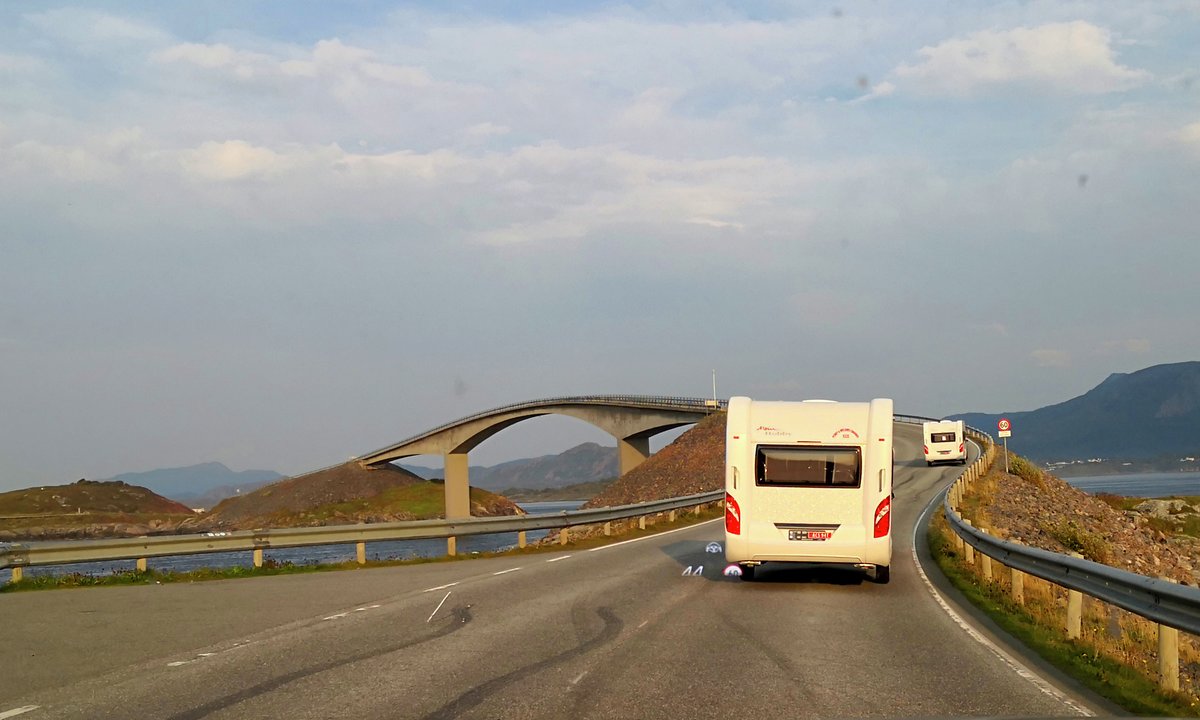
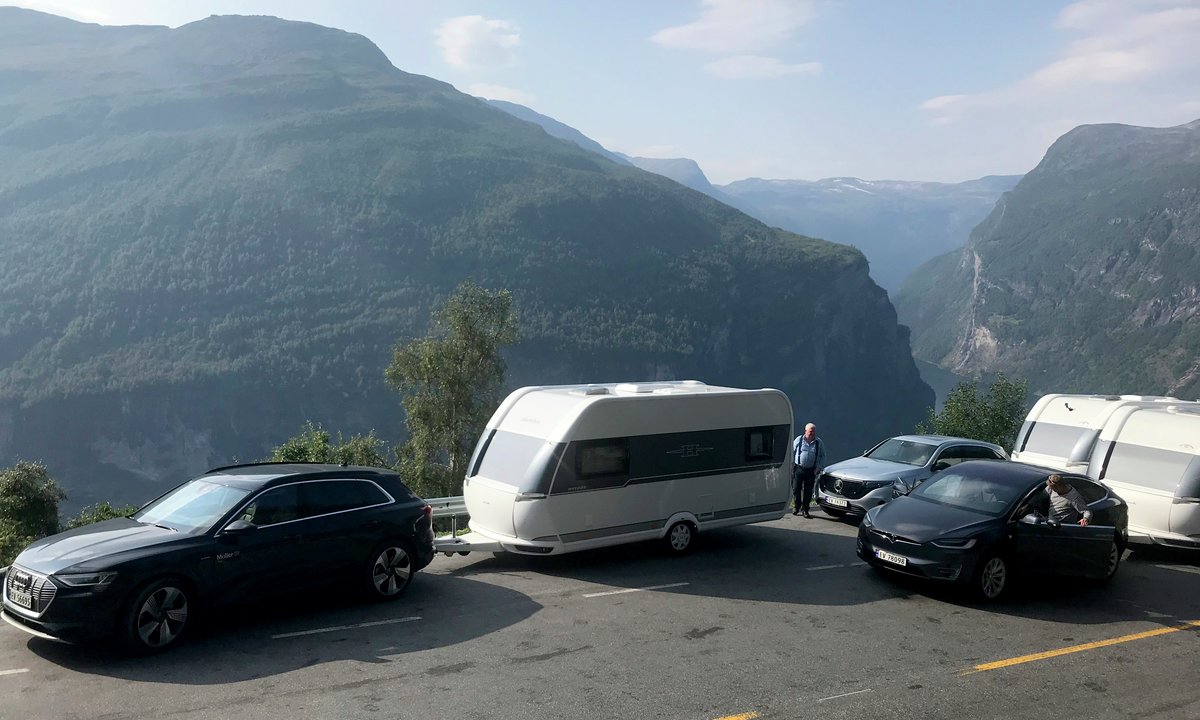 Completely safe overtaking, with caravans behind them, is no problem with these cars.
Completely safe overtaking, with caravans behind them, is no problem with these cars.
 Both camping sites we visited were 100 per cent accommodating, but neither could provide modern and safe charging equipment. Happily, during conversations, their representatives expressed an interest in preparing for future camping tourism.
Both camping sites we visited were 100 per cent accommodating, but neither could provide modern and safe charging equipment. Happily, during conversations, their representatives expressed an interest in preparing for future camping tourism.
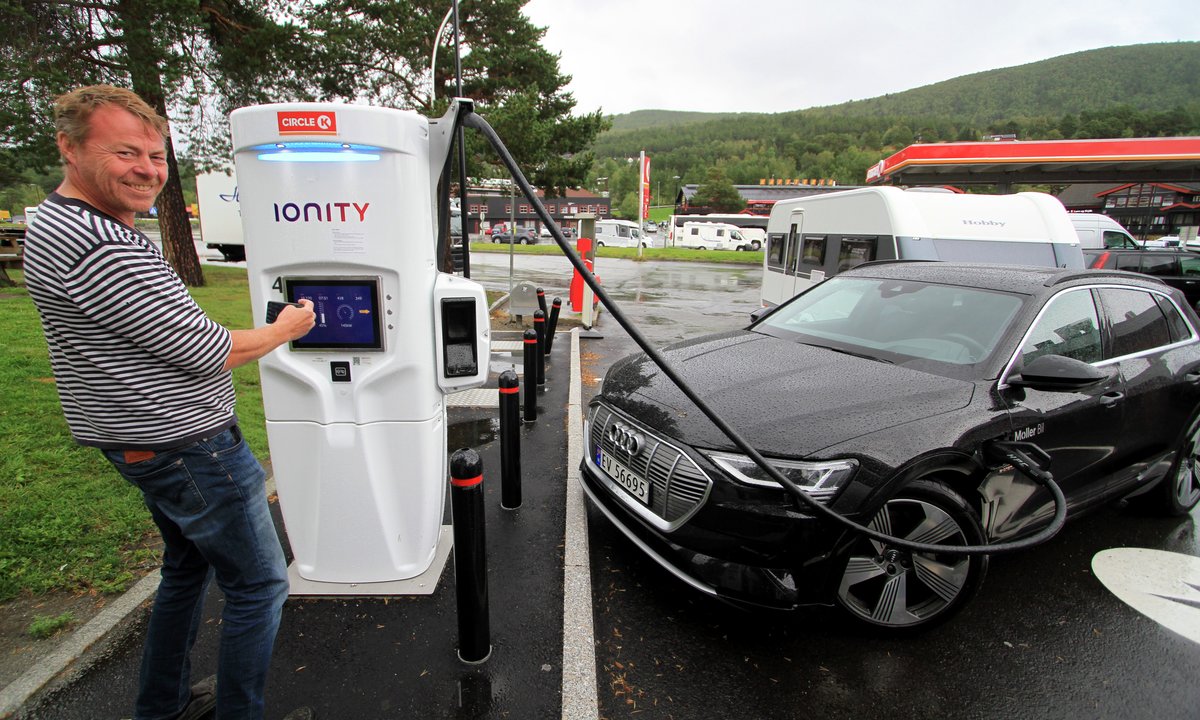 During this test, we also got the chance to test the relatively new charge point operator (CPO) IONITY on several occasions. All of them showed solid charging speeds.
The Audi e-tron has repeatedly shown it can be «filled up» in just 30 minutes (max power 150 kW), meaning increased consumption due to towing is zero problem.
During this test, we also got the chance to test the relatively new charge point operator (CPO) IONITY on several occasions. All of them showed solid charging speeds.
The Audi e-tron has repeatedly shown it can be «filled up» in just 30 minutes (max power 150 kW), meaning increased consumption due to towing is zero problem.
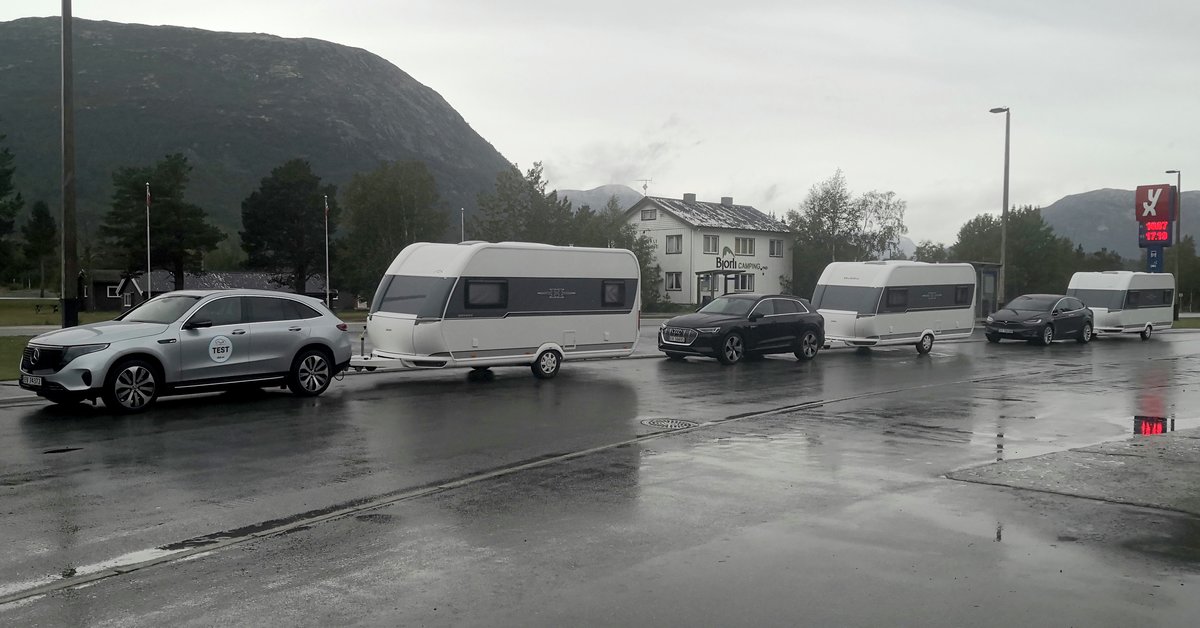 The wet road surface did, however, offer an additional test opportunity, after several late August days with perfect weather.
The highest temperature was in Åndalsnes the day before, a massive 32 degrees Celsius, so we were happy to experience a humid counterbalance.
As the numbers show (in the table below) the added rolling resistance from wet roads did not result in a dramatic consumption increase. We did not do thorough calculations regarding altitude, but even so, there is no doubt electricity consumption would have been lower for all three cars if the weather had stayed sunny.
All of the tractors were fully charged leaving Dombås, located 659 meters above sea level. Compared to Nebbenes, where the Model X was fast charged after driving 275 kilometres, the difference in altitude is roughly 500 meters.
We had planned for a short stopover at Fortum Charge & Drive´s fast charger at Ringebu for the e-tron and EQC, to make them able to reach the IONITY high power charger at Dal, near E6 just north of Oslo. Near the charger, in scenic Gudbrandsdalen we were luckily able to charge two of the cars without disconnecting the caravans.
The wet road surface did, however, offer an additional test opportunity, after several late August days with perfect weather.
The highest temperature was in Åndalsnes the day before, a massive 32 degrees Celsius, so we were happy to experience a humid counterbalance.
As the numbers show (in the table below) the added rolling resistance from wet roads did not result in a dramatic consumption increase. We did not do thorough calculations regarding altitude, but even so, there is no doubt electricity consumption would have been lower for all three cars if the weather had stayed sunny.
All of the tractors were fully charged leaving Dombås, located 659 meters above sea level. Compared to Nebbenes, where the Model X was fast charged after driving 275 kilometres, the difference in altitude is roughly 500 meters.
We had planned for a short stopover at Fortum Charge & Drive´s fast charger at Ringebu for the e-tron and EQC, to make them able to reach the IONITY high power charger at Dal, near E6 just north of Oslo. Near the charger, in scenic Gudbrandsdalen we were luckily able to charge two of the cars without disconnecting the caravans.
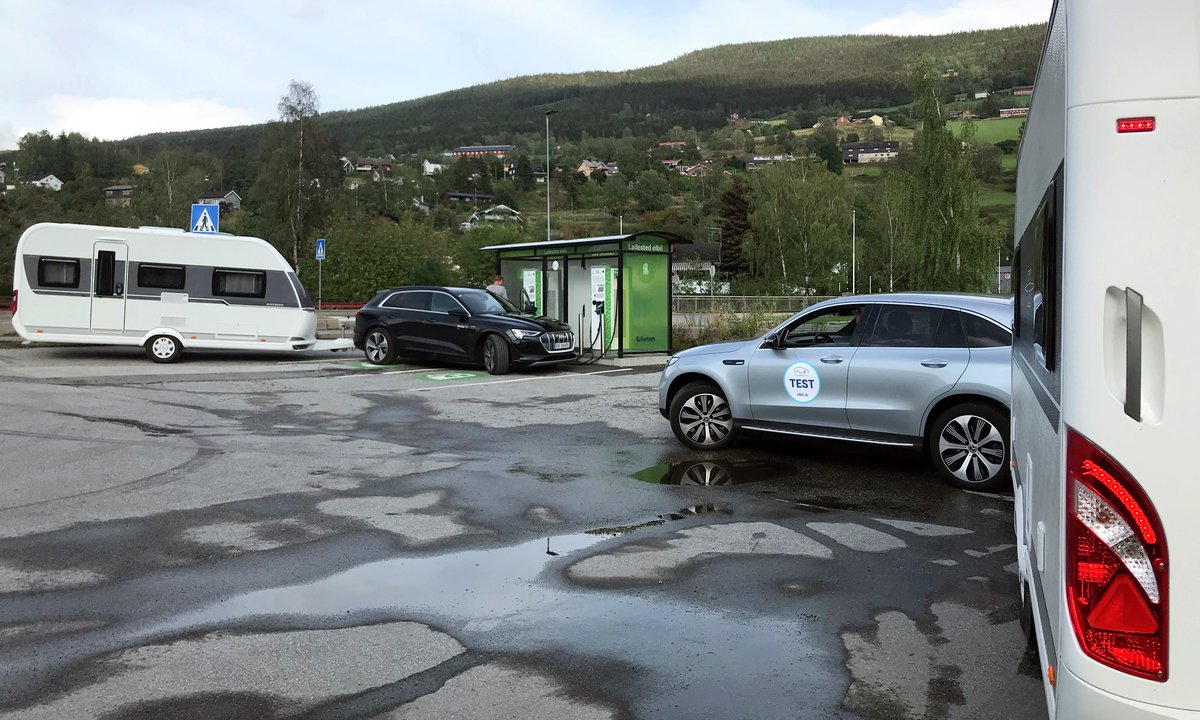 One of the chargers were, unfortunately, out of service which meant that we had to use a different charger, and as a result, had to disconnect one of the caravans.
As the consumption stayed higher than anticipated, both cars needed another break underway to Dal. In total, the two quick fill-ups meant an extra 25 minutes for the whole stretch.
When night fell, the test team was able to gather once again at the IONITY high power charger.
One of the chargers were, unfortunately, out of service which meant that we had to use a different charger, and as a result, had to disconnect one of the caravans.
As the consumption stayed higher than anticipated, both cars needed another break underway to Dal. In total, the two quick fill-ups meant an extra 25 minutes for the whole stretch.
When night fell, the test team was able to gather once again at the IONITY high power charger.
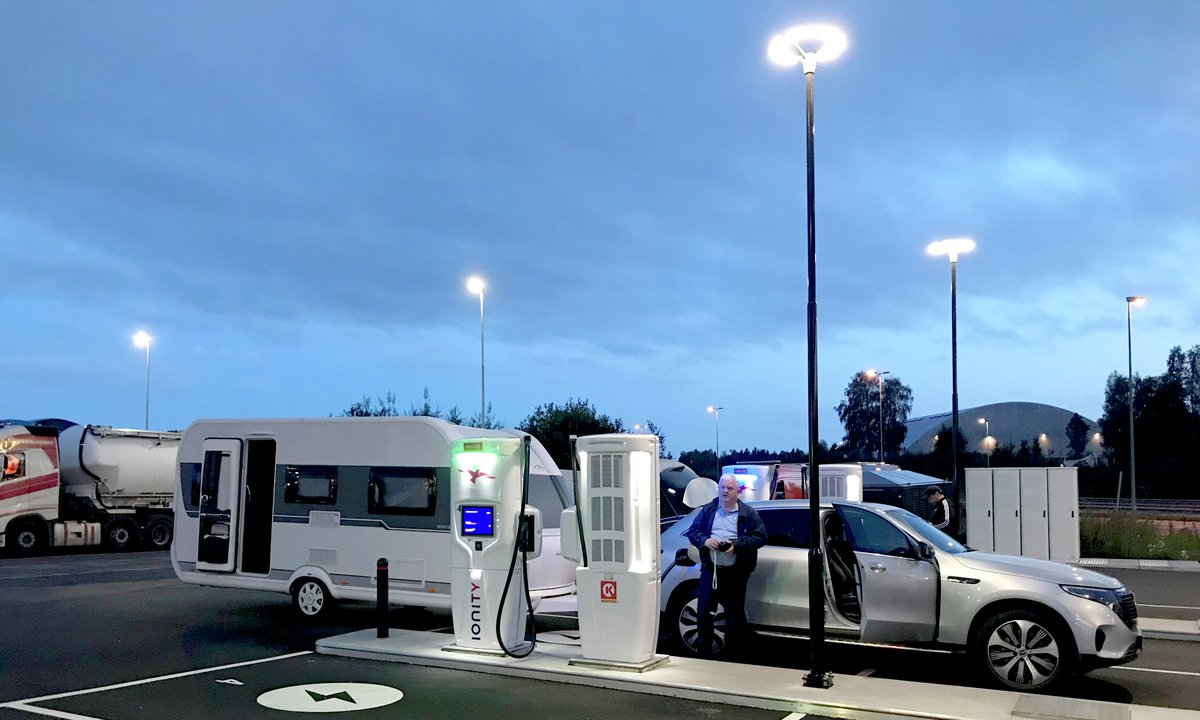
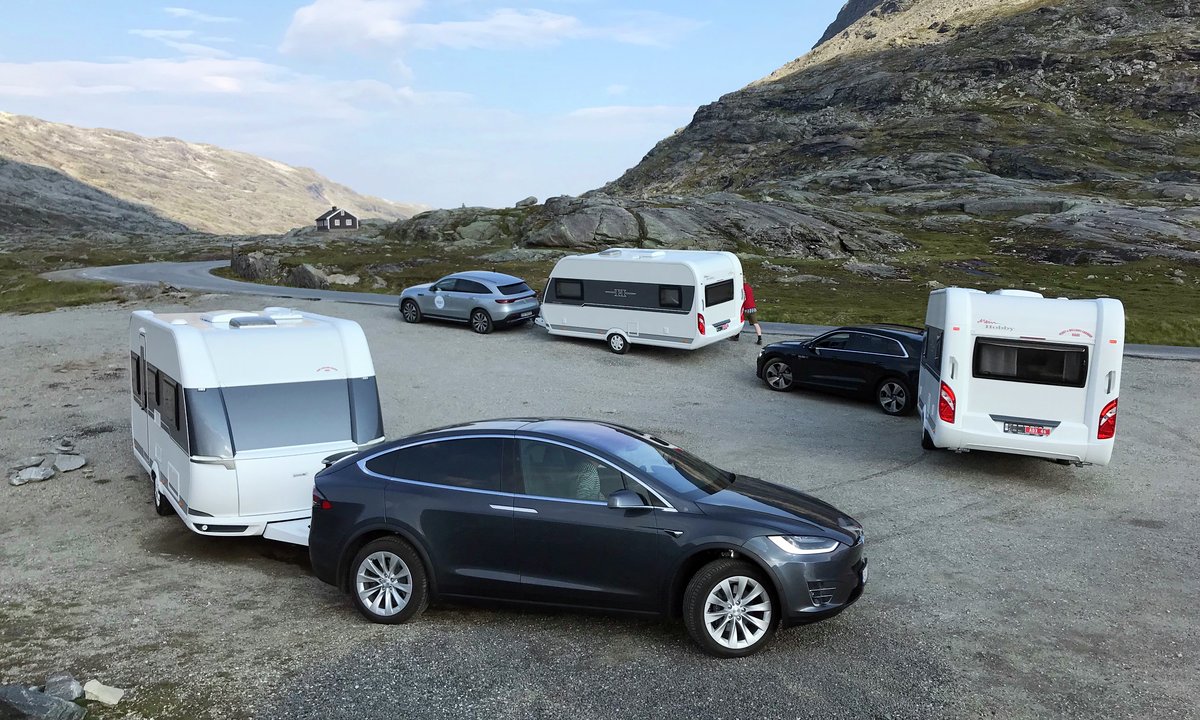 Or maybe something else and indefinable.
The Audi is the «most fuel-thirsty» of the three, probably also if rim and tire size is adjusted to 20 inches. But it holds a trump card: It can fast-charge at 150 kW, meaning a full charge usually requires around 30 minutes.
This is the chief Audi advantage. For all other relevant criteria, we consider Tesla and EQC to deliver better.
Or maybe something else and indefinable.
The Audi is the «most fuel-thirsty» of the three, probably also if rim and tire size is adjusted to 20 inches. But it holds a trump card: It can fast-charge at 150 kW, meaning a full charge usually requires around 30 minutes.
This is the chief Audi advantage. For all other relevant criteria, we consider Tesla and EQC to deliver better.
 The Model X is undoubtedly the best tractor if all factors are considered. In ideal conditions, it can tow the caravan used in this test 300 kilometres in one charge, while the competitors must settle for 230-240. The reasonable choice is to assume 250 kilometres for the Model X and 200 for «the germans» if you do not have a full overview of topography and consumption.
If the road is mostly flat, the Model X might continue for 320-330 kilometres with a caravan comparable to the one used in this test, while the corresponding maximum for EQC and e-tron is probably around 260-270.
The Model X has the largest battery pack, the highest towing capacity and the lowest consumption of the three (it has become even more efficient with electric motor and controls from Model 3), but at the same time, it is more expensive than the other two.
The Model X is undoubtedly the best tractor if all factors are considered. In ideal conditions, it can tow the caravan used in this test 300 kilometres in one charge, while the competitors must settle for 230-240. The reasonable choice is to assume 250 kilometres for the Model X and 200 for «the germans» if you do not have a full overview of topography and consumption.
If the road is mostly flat, the Model X might continue for 320-330 kilometres with a caravan comparable to the one used in this test, while the corresponding maximum for EQC and e-tron is probably around 260-270.
The Model X has the largest battery pack, the highest towing capacity and the lowest consumption of the three (it has become even more efficient with electric motor and controls from Model 3), but at the same time, it is more expensive than the other two.
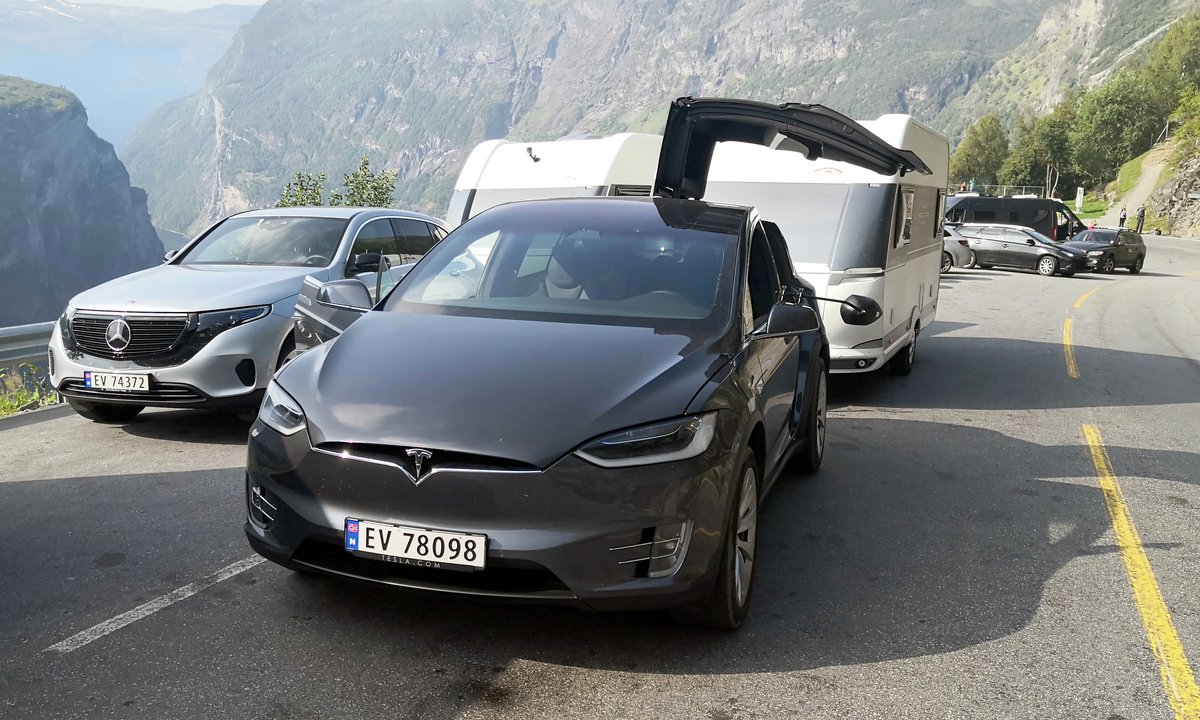 The driving comfort of the Model X is also better due to improved noise insulation, meaning the difference to EQC and e-tron is, to a large extent, erased. Currently, the car has just one range indicator, after the Typical mode (EPA) and Rated (NEDC) has been replaced by Standard (WLTP). It behaves a bit strange in the way that it does not relate its estimate to the caravan.
Both German BEVs do this in a trustworthy manner.
The Mercedes-Benz EQC 400 offers brilliant driving comfort. It has way better range than we expected, based on the first impression, it is quiet and adapts to the caravan nicely. It feels like the suspension (coil springs front and air suspension rear) is less affected by the caravan than Model X and e-tron, and thereby more harmonious.
All three have plenty of power and can do overtaking with the caravans completely hassle-free.
The driving comfort of the Model X is also better due to improved noise insulation, meaning the difference to EQC and e-tron is, to a large extent, erased. Currently, the car has just one range indicator, after the Typical mode (EPA) and Rated (NEDC) has been replaced by Standard (WLTP). It behaves a bit strange in the way that it does not relate its estimate to the caravan.
Both German BEVs do this in a trustworthy manner.
The Mercedes-Benz EQC 400 offers brilliant driving comfort. It has way better range than we expected, based on the first impression, it is quiet and adapts to the caravan nicely. It feels like the suspension (coil springs front and air suspension rear) is less affected by the caravan than Model X and e-tron, and thereby more harmonious.
All three have plenty of power and can do overtaking with the caravans completely hassle-free.
 The verdict? All three passed the test, but each with their pluses and minuses. When it comes to increased electricity consumption, it is reasonable to expect 80-90 per cent on the type of trip we did.
On flat road surface with smooth driving, it is a different story, probably just 50-60 per cent more than regular consumption.
We would kindly suggest to not push the envelope. In practical terms: Don’t approach the area around 0 kilometres on the range indicator. Depending on how well the battery cells are balanced, you might run out of energy before or after zero.
The negative experience this can lead to is probably not on your bucket list.
It is important to underline the fact that we conducted this test within a tight time frame. We recommend spending way more time on a camping trip like this. Enjoy the scenery. Enjoy the fast charging breaks. When the high-power charging network gets more fine-meshed and more camping sites to offer safe and reliable AC charging, it will be a stress-free experience.
The verdict? All three passed the test, but each with their pluses and minuses. When it comes to increased electricity consumption, it is reasonable to expect 80-90 per cent on the type of trip we did.
On flat road surface with smooth driving, it is a different story, probably just 50-60 per cent more than regular consumption.
We would kindly suggest to not push the envelope. In practical terms: Don’t approach the area around 0 kilometres on the range indicator. Depending on how well the battery cells are balanced, you might run out of energy before or after zero.
The negative experience this can lead to is probably not on your bucket list.
It is important to underline the fact that we conducted this test within a tight time frame. We recommend spending way more time on a camping trip like this. Enjoy the scenery. Enjoy the fast charging breaks. When the high-power charging network gets more fine-meshed and more camping sites to offer safe and reliable AC charging, it will be a stress-free experience.
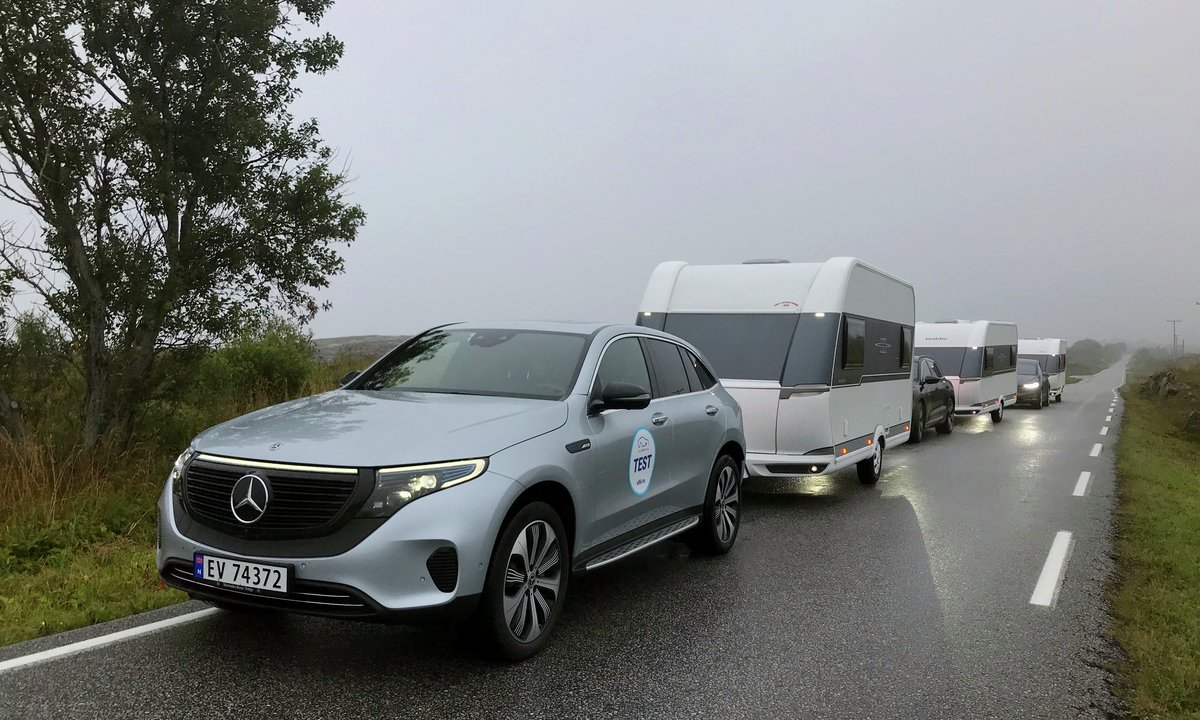
 This test is mostly about how the three BEVs delivered as tractors, the relative difference in electric consumption versus normal driving and how charging infrastructure – or lack thereof – affects a trip like the one we did.
We did not spend much time discussing trim levels and options on the different cars. This was basically towing.
Watch video!
We utilized adaptive cruise control to a large extent during the test, especially on the long country road stretches. On the narrow and winding roads of Western Norway, we drove without any speed keeping assistance, off course.
Also, we did not utilize any Eco-driving programs, except the Audi, got to keep its «Efficiency» program as it lowers the car – and does not leave an egg under the throttle.
The temperatures inside the car ranged between 17-20 degrees Celsius, depending on outside temperatures, and air conditioning available throughout the trip. In short: With modern BEVs, we believe one should treat oneself to the desired level of comfort, even when towing heavy stuff.
To make the cars in the test close to 100 per cent comparable, the Audi should have had 20-inch wheels, just like the Tesla and the EQC. The only problem was: The car made available lacked a tow bar. We got hold of another e-tron on 21-inch wheels, which might have affected the range negatively.
After finishing the test, we are still wondering what difference one inch less would have made, although the roll circumference of the wheels was similar.
This test is mostly about how the three BEVs delivered as tractors, the relative difference in electric consumption versus normal driving and how charging infrastructure – or lack thereof – affects a trip like the one we did.
We did not spend much time discussing trim levels and options on the different cars. This was basically towing.
Watch video!
We utilized adaptive cruise control to a large extent during the test, especially on the long country road stretches. On the narrow and winding roads of Western Norway, we drove without any speed keeping assistance, off course.
Also, we did not utilize any Eco-driving programs, except the Audi, got to keep its «Efficiency» program as it lowers the car – and does not leave an egg under the throttle.
The temperatures inside the car ranged between 17-20 degrees Celsius, depending on outside temperatures, and air conditioning available throughout the trip. In short: With modern BEVs, we believe one should treat oneself to the desired level of comfort, even when towing heavy stuff.
To make the cars in the test close to 100 per cent comparable, the Audi should have had 20-inch wheels, just like the Tesla and the EQC. The only problem was: The car made available lacked a tow bar. We got hold of another e-tron on 21-inch wheels, which might have affected the range negatively.
After finishing the test, we are still wondering what difference one inch less would have made, although the roll circumference of the wheels was similar.

«Get to know-day» for three inexperienced camping dudes
Locating three identical caravans for this test proved to be somewhat of a challenge. However, with a little help, we got in touch with dealer Perry & Williams Caravan in Råde, Østfold. They liked our idea and could swiftly confirm rental of three Hobby 460 DL on Tour caravans. Thanks a lot! The caravans were 6.6 meters long, fitted three adults (or two adults and two children) and met our desire for «capable caravans for driving». Not too light, not too heavy. At the same time, they offered a much-welcomed aerodynamic challenge. To get a frame of reference for electricity consumption, we reset the trip odometers before driving from the Oslo to Østfold county, roughly 80 kilometres.
The average speed was low and «caravan suitable», at 70 km/h. The Tesla made do with 17.6 kWh/100 km, while the EQC demanded 18.9 and the e-tron 21.2.
We were all excited to see just what the Mercedes-Benz EQC 400 could accomplish during heavy towing. During the first test drive in May, the new BEV felt both heavy and inefficient. But, surprisingly, the consumption now was just barely higher with the caravan behind it than that wintery day in May.
Back on the outskirts of Oslo consumption was 29.3 kWh/100 km, with an average speed of 76 km/h. The increase was just 55 per cent. The Model X consumed 28.4 (61 per cent increase), while the e-tron showed 31.8 (50 per cent increase) – with experienced tester Øyvind Lunde behind the wheel.
To get a frame of reference for electricity consumption, we reset the trip odometers before driving from the Oslo to Østfold county, roughly 80 kilometres.
The average speed was low and «caravan suitable», at 70 km/h. The Tesla made do with 17.6 kWh/100 km, while the EQC demanded 18.9 and the e-tron 21.2.
We were all excited to see just what the Mercedes-Benz EQC 400 could accomplish during heavy towing. During the first test drive in May, the new BEV felt both heavy and inefficient. But, surprisingly, the consumption now was just barely higher with the caravan behind it than that wintery day in May.
Back on the outskirts of Oslo consumption was 29.3 kWh/100 km, with an average speed of 76 km/h. The increase was just 55 per cent. The Model X consumed 28.4 (61 per cent increase), while the e-tron showed 31.8 (50 per cent increase) – with experienced tester Øyvind Lunde behind the wheel.
 The rest of the day was spent familiarizing ourselves with both the BEVs and the caravans. After weighing the trailers, we got the necessary evidence: Caravans weighed in at 1.160 kilograms, a little bit less than fully equipped at 1.200. Maximum allowed weight for this Hobby caravan is 1.500 kilograms.
The Model X was the lightest among the BEVs, at 2.505 kilograms, with EQC as the runner-up at 2.568. The e-tron proved to weigh 2.660. The weight of the test drivers varied between 80 and a little more than 100 kilograms, but this difference was evened out by switching seats regularly.
We stayed overnight in a municipal parking lot, with some Mode 3 Type 2 slow charging, to be ready for the next day and some serious long-haul driving.
The rest of the day was spent familiarizing ourselves with both the BEVs and the caravans. After weighing the trailers, we got the necessary evidence: Caravans weighed in at 1.160 kilograms, a little bit less than fully equipped at 1.200. Maximum allowed weight for this Hobby caravan is 1.500 kilograms.
The Model X was the lightest among the BEVs, at 2.505 kilograms, with EQC as the runner-up at 2.568. The e-tron proved to weigh 2.660. The weight of the test drivers varied between 80 and a little more than 100 kilograms, but this difference was evened out by switching seats regularly.
We stayed overnight in a municipal parking lot, with some Mode 3 Type 2 slow charging, to be ready for the next day and some serious long-haul driving.
The first real range test – #firsttestday
The first test day was to offer 350 kilometres of driving with caravans, in addition to a reference test (120 kilometres) without towing. The first leg: 226 kilometres from Nittedal to Vinstra, well north of Olympic city Lillehammer, along State Highway 4 and European Road 6. We started out with a temperature of 13,5 degrees Celsius, before enjoying nice summer temperatures (27) at Otta in the evening. The Model X showed just what a tractor it is. No range anxiety whatsoever, and it arrived at the Supercharger in Vinstra with another estimated 115 kilometres left in the battery pack. With its estimated 98 kilowatt-hours (kWh) of stored energy, it only makes sense.
The EQC had no problems either, even though the estimated range was just 8 kilometres (from 80 kWh of usable capacity). To connect to the charger, we, rather unhandily, had to disconnect the caravan, as the EQC has its charge port on the right rear fender.
With the Audi we had to make a reasonable decision, even though it has 4 kWh more stored energy than the EQC. Arriving at Fåvång, with 35 kilometres more to reach Vinstra, the «guessometer» estimated 40 kilometres of range, which would be a bit of a stretch. The solution was a bit of 50 kW fast charging outside the local KIWI grocery store, and an extra 4.1 kWh – or estimated 13 kilometres of range.
The Audi charge port, which is located on the front left fender, was handy this time. It meant we had to disconnect the caravan just a few times during the test.
The Model X showed just what a tractor it is. No range anxiety whatsoever, and it arrived at the Supercharger in Vinstra with another estimated 115 kilometres left in the battery pack. With its estimated 98 kilowatt-hours (kWh) of stored energy, it only makes sense.
The EQC had no problems either, even though the estimated range was just 8 kilometres (from 80 kWh of usable capacity). To connect to the charger, we, rather unhandily, had to disconnect the caravan, as the EQC has its charge port on the right rear fender.
With the Audi we had to make a reasonable decision, even though it has 4 kWh more stored energy than the EQC. Arriving at Fåvång, with 35 kilometres more to reach Vinstra, the «guessometer» estimated 40 kilometres of range, which would be a bit of a stretch. The solution was a bit of 50 kW fast charging outside the local KIWI grocery store, and an extra 4.1 kWh – or estimated 13 kilometres of range.
The Audi charge port, which is located on the front left fender, was handy this time. It meant we had to disconnect the caravan just a few times during the test.
 Finally arriving at Vinstra, the e-tron had some 11 estimated kilometres left (equals 4 per cent state of charge, SOC). This means we would likely have run out of energy without the extra fast charging break.
It is important to be aware of this experience: Nobody wants to be left with an empty battery on the roadside, especially on a camping trip. Better safe than sorry.
To get to 80 per cent SOC we had to spend roughly one and a half hour at the 50 kW DC charger (average power: 43,4 kW). The EQC needed a bit more time, with an average charging power around 40 kW.
Crowds of BEVs and caravans on tour is by far a daily sight, even in Norway, but we would have loved faster charging in this location. Aside from Tesla´s Supercharger, you will only find 50 kW chargers here, operated by CPOs Fortum Charge & Drive and Grønn Kontakt.
Finally arriving at Vinstra, the e-tron had some 11 estimated kilometres left (equals 4 per cent state of charge, SOC). This means we would likely have run out of energy without the extra fast charging break.
It is important to be aware of this experience: Nobody wants to be left with an empty battery on the roadside, especially on a camping trip. Better safe than sorry.
To get to 80 per cent SOC we had to spend roughly one and a half hour at the 50 kW DC charger (average power: 43,4 kW). The EQC needed a bit more time, with an average charging power around 40 kW.
Crowds of BEVs and caravans on tour is by far a daily sight, even in Norway, but we would have loved faster charging in this location. Aside from Tesla´s Supercharger, you will only find 50 kW chargers here, operated by CPOs Fortum Charge & Drive and Grønn Kontakt.
 More high-power chargers (HPC) are highly desired – with or without caravans. And this nice and otherwise spacious location should most definitely have had a larger variety of plugs.
Luckily the Tesla Supercharger was not too busy, meaning we could occupy five stalls and avoid disconnecting. This is of course not recommended at «rush hour», and we would also have been unable to turn around with the caravan. We would have been left to back the trailer all the way.
Parallel parking by the fast charger, just like several Tesla Supercharger and IONITY locations have in Norway, is by far the best alternative.
More high-power chargers (HPC) are highly desired – with or without caravans. And this nice and otherwise spacious location should most definitely have had a larger variety of plugs.
Luckily the Tesla Supercharger was not too busy, meaning we could occupy five stalls and avoid disconnecting. This is of course not recommended at «rush hour», and we would also have been unable to turn around with the caravan. We would have been left to back the trailer all the way.
Parallel parking by the fast charger, just like several Tesla Supercharger and IONITY locations have in Norway, is by far the best alternative.
The difference with and without a caravan
After arriving at Otta, we disconnected the caravans and left them guarded in a parking lot. We planned to drive the same distance to Vågåmo (29.6 kilometres), back and forth, both with and without the caravans. The average speed on both legs was 68-69 km/h and the temperatures were between 24 and 27 degrees Celsius. The goal was to determine the percentage difference in electricity consumption during the roughly 120 kilometres. It was a bit bigger than we first imagined, but it wasn’t really an issue. The Model X proved to be a clear winner, once again with the EQC right behind. The e-tron proved quite a tad more fuel-hungry.Regenerating in Postcard Norway- #secondtestday
The second day we took off from beautiful camping site Dønfoss in Skjåk municipality at 7.15 in the morning. First stop: Charging at a 50-kW fast charger near Grotli mountain lodge and a quick breakfast for the test team. The e-tron had refused any attempt to do some old fashioned Schuko slow-charging, due to the quality of grounding. We had no success trying to reset the Mode 2 charging unit. After a full charge, we left for famous viewpoint Dalsnibba. Then on to tourist hot spot Geiranger, and further on Ørnevegen to Eidsdal, and the first of three ferry stretches. Then we continued from «Strawberry Village» Valldal to Trollstigen and Åndalsnes. On this leg we introduced a specific test procedure, to see just how much «free fuel» you can get driving a BEV.
And, as we realized, even more, when towing a caravan. That happened even though the brakes of the caravans were in use more than we would have preferred, leading to less regeneration and «hot caravan wheels». This was both visible and «smellable» after the steepest descents underway.
We left Grotli with 100 per cent SOC on the two German cars, and 99 on the Model X. As the table shows, all the cars were able to regenerate as much electricity during the descent from Dalsnibba as consumed during the climb on Ørnevegen on the opposite side of Geiranger.
After a full charge, we left for famous viewpoint Dalsnibba. Then on to tourist hot spot Geiranger, and further on Ørnevegen to Eidsdal, and the first of three ferry stretches. Then we continued from «Strawberry Village» Valldal to Trollstigen and Åndalsnes. On this leg we introduced a specific test procedure, to see just how much «free fuel» you can get driving a BEV.
And, as we realized, even more, when towing a caravan. That happened even though the brakes of the caravans were in use more than we would have preferred, leading to less regeneration and «hot caravan wheels». This was both visible and «smellable» after the steepest descents underway.
We left Grotli with 100 per cent SOC on the two German cars, and 99 on the Model X. As the table shows, all the cars were able to regenerate as much electricity during the descent from Dalsnibba as consumed during the climb on Ørnevegen on the opposite side of Geiranger.
 Arriving at the ferry port of Eidsdal, we were back on the same SOC as when we left Dalsnibba. The stretch from Valldal to Alnesreset (highest above sea level before Trollstigen) meant climbing 850 meters. This resulted in a steep increase in electricity consumption for all three cars, while the Trollstigen descent regenerated enough energy for the trip to Åndalsnes.
The rest of the day, on better State Highways, showed very stable consumption numbers until we called it a day in Averøy, some 160 kilometres later.
Arriving at the ferry port of Eidsdal, we were back on the same SOC as when we left Dalsnibba. The stretch from Valldal to Alnesreset (highest above sea level before Trollstigen) meant climbing 850 meters. This resulted in a steep increase in electricity consumption for all three cars, while the Trollstigen descent regenerated enough energy for the trip to Åndalsnes.
The rest of the day, on better State Highways, showed very stable consumption numbers until we called it a day in Averøy, some 160 kilometres later.

Pure delight with BEVs as tractors
The ability of BEVs to regenerate a lot of energy in the hilly fjord landscape has been mentioned. This means excess consumption during climbs, to some resulting in temporary range anxiety, is evened out to a large extent. The greatest pleasure was nevertheless cruising almost without any noise through the beautiful scenery that Norway has to offer. The stress-free driving experience BEVs offer, in general, was taken to a new and unknown level for the whole test team. Yes, we have driven a lot with trailers. But never with BEVs as tractors. Completely safe overtaking, with caravans behind them, is no problem with these cars.
Completely safe overtaking, with caravans behind them, is no problem with these cars.
What needs to be done to make it hassle free?
What is needed from infrastructure to take BEVs and caravans for long trips, now and in the future? Our 1.381-kilometre long trip gave quite a few suggestions. We did not make any particular precautions regarding charging in the camping sites we visited. You might hook up electricity to your caravan using a grounded socket (Schuko), and in exceptional cases, the same sockets may be used for charging overnight. The latter is only the case if the electrical system is proper and does not include an extension cord to a socket in a nearby cabin. This was the case at Atlanterhavsveien Sjøstuer (picture below), where we chose to say «no thanks» even though we hardly had any range left. Safety must come first. The range was nevertheless sufficient to get to Molde in the morning, but it is worth pointing out that this part of Norway is scarcely populated with fast chargers. Given that another infrastructure for slow charging is as bad, with just a few Mode 3 Type 2 chargers available, the potential for improvement is significant. Camping sites that facilitate charging, utilizing safe and dedicated equipment, will have a competitive advantage in the years to come. Not least because camping based on zero-emission travel – and locally produced renewable energy – is a perfect combination. Both camping sites we visited were 100 per cent accommodating, but neither could provide modern and safe charging equipment. Happily, during conversations, their representatives expressed an interest in preparing for future camping tourism.
Both camping sites we visited were 100 per cent accommodating, but neither could provide modern and safe charging equipment. Happily, during conversations, their representatives expressed an interest in preparing for future camping tourism.
Fast charging has to be fast
When it comes to fast charging it is a great advantage if it actually is fast, as heavy trailers significantly increase the electricity consumption of BEVs. Our use of rural 50 kW DC chargers was mostly flawless, but lower power requires quite a bit of waiting. The whole charging experience with a caravan can be quite tiring when only charging at 50 kW unless you take a power nap or play some chess in the caravan of course. But BEVs with larger battery packs and ditto charging-needs may create unmanageable queues on busy fast-charging stations. Efficient charging stations with high power and numerous charging plugs are so far mostly associated with Tesla, which means the Model X is by far the easiest BEV when bringing a caravan along. The network of Superchargers is, furthermore, so extensive one can drive almost anywhere in Norway. The remaining network of high-power chargers (HPC) is currently scarce, but luckily growing at a steady pace. During this test, we also got the chance to test the relatively new charge point operator (CPO) IONITY on several occasions. All of them showed solid charging speeds.
The Audi e-tron has repeatedly shown it can be «filled up» in just 30 minutes (max power 150 kW), meaning increased consumption due to towing is zero problem.
During this test, we also got the chance to test the relatively new charge point operator (CPO) IONITY on several occasions. All of them showed solid charging speeds.
The Audi e-tron has repeatedly shown it can be «filled up» in just 30 minutes (max power 150 kW), meaning increased consumption due to towing is zero problem.
Long wet journey – #thirdtestday
Unlike the previous days, the last day turned out to be rather wet. We woke up to low rainy clouds in the morning which were followed by heavy showers that continued for hours. The rain was at its worst between Molde and Åndalsnes. The wet road surface did, however, offer an additional test opportunity, after several late August days with perfect weather.
The highest temperature was in Åndalsnes the day before, a massive 32 degrees Celsius, so we were happy to experience a humid counterbalance.
As the numbers show (in the table below) the added rolling resistance from wet roads did not result in a dramatic consumption increase. We did not do thorough calculations regarding altitude, but even so, there is no doubt electricity consumption would have been lower for all three cars if the weather had stayed sunny.
All of the tractors were fully charged leaving Dombås, located 659 meters above sea level. Compared to Nebbenes, where the Model X was fast charged after driving 275 kilometres, the difference in altitude is roughly 500 meters.
We had planned for a short stopover at Fortum Charge & Drive´s fast charger at Ringebu for the e-tron and EQC, to make them able to reach the IONITY high power charger at Dal, near E6 just north of Oslo. Near the charger, in scenic Gudbrandsdalen we were luckily able to charge two of the cars without disconnecting the caravans.
The wet road surface did, however, offer an additional test opportunity, after several late August days with perfect weather.
The highest temperature was in Åndalsnes the day before, a massive 32 degrees Celsius, so we were happy to experience a humid counterbalance.
As the numbers show (in the table below) the added rolling resistance from wet roads did not result in a dramatic consumption increase. We did not do thorough calculations regarding altitude, but even so, there is no doubt electricity consumption would have been lower for all three cars if the weather had stayed sunny.
All of the tractors were fully charged leaving Dombås, located 659 meters above sea level. Compared to Nebbenes, where the Model X was fast charged after driving 275 kilometres, the difference in altitude is roughly 500 meters.
We had planned for a short stopover at Fortum Charge & Drive´s fast charger at Ringebu for the e-tron and EQC, to make them able to reach the IONITY high power charger at Dal, near E6 just north of Oslo. Near the charger, in scenic Gudbrandsdalen we were luckily able to charge two of the cars without disconnecting the caravans.
 One of the chargers were, unfortunately, out of service which meant that we had to use a different charger, and as a result, had to disconnect one of the caravans.
As the consumption stayed higher than anticipated, both cars needed another break underway to Dal. In total, the two quick fill-ups meant an extra 25 minutes for the whole stretch.
When night fell, the test team was able to gather once again at the IONITY high power charger.
One of the chargers were, unfortunately, out of service which meant that we had to use a different charger, and as a result, had to disconnect one of the caravans.
As the consumption stayed higher than anticipated, both cars needed another break underway to Dal. In total, the two quick fill-ups meant an extra 25 minutes for the whole stretch.
When night fell, the test team was able to gather once again at the IONITY high power charger.

Taste and comfort decide the winner
Underway we were frequently asked which one was the better tractor. That question requires both then and now a detailed and nuanced answer. You see, each of the BEVs is in all important respects a winner. The essential factor is what is the most important to the potential owner: Maximum range, pricing point, maximum towing weight, optimal fast charging speed, optimal fast-charging network or driving comfort. Or maybe something else and indefinable.
The Audi is the «most fuel-thirsty» of the three, probably also if rim and tire size is adjusted to 20 inches. But it holds a trump card: It can fast-charge at 150 kW, meaning a full charge usually requires around 30 minutes.
This is the chief Audi advantage. For all other relevant criteria, we consider Tesla and EQC to deliver better.
Or maybe something else and indefinable.
The Audi is the «most fuel-thirsty» of the three, probably also if rim and tire size is adjusted to 20 inches. But it holds a trump card: It can fast-charge at 150 kW, meaning a full charge usually requires around 30 minutes.
This is the chief Audi advantage. For all other relevant criteria, we consider Tesla and EQC to deliver better.
 The Model X is undoubtedly the best tractor if all factors are considered. In ideal conditions, it can tow the caravan used in this test 300 kilometres in one charge, while the competitors must settle for 230-240. The reasonable choice is to assume 250 kilometres for the Model X and 200 for «the germans» if you do not have a full overview of topography and consumption.
If the road is mostly flat, the Model X might continue for 320-330 kilometres with a caravan comparable to the one used in this test, while the corresponding maximum for EQC and e-tron is probably around 260-270.
The Model X has the largest battery pack, the highest towing capacity and the lowest consumption of the three (it has become even more efficient with electric motor and controls from Model 3), but at the same time, it is more expensive than the other two.
The Model X is undoubtedly the best tractor if all factors are considered. In ideal conditions, it can tow the caravan used in this test 300 kilometres in one charge, while the competitors must settle for 230-240. The reasonable choice is to assume 250 kilometres for the Model X and 200 for «the germans» if you do not have a full overview of topography and consumption.
If the road is mostly flat, the Model X might continue for 320-330 kilometres with a caravan comparable to the one used in this test, while the corresponding maximum for EQC and e-tron is probably around 260-270.
The Model X has the largest battery pack, the highest towing capacity and the lowest consumption of the three (it has become even more efficient with electric motor and controls from Model 3), but at the same time, it is more expensive than the other two.
 The driving comfort of the Model X is also better due to improved noise insulation, meaning the difference to EQC and e-tron is, to a large extent, erased. Currently, the car has just one range indicator, after the Typical mode (EPA) and Rated (NEDC) has been replaced by Standard (WLTP). It behaves a bit strange in the way that it does not relate its estimate to the caravan.
Both German BEVs do this in a trustworthy manner.
The Mercedes-Benz EQC 400 offers brilliant driving comfort. It has way better range than we expected, based on the first impression, it is quiet and adapts to the caravan nicely. It feels like the suspension (coil springs front and air suspension rear) is less affected by the caravan than Model X and e-tron, and thereby more harmonious.
All three have plenty of power and can do overtaking with the caravans completely hassle-free.
The driving comfort of the Model X is also better due to improved noise insulation, meaning the difference to EQC and e-tron is, to a large extent, erased. Currently, the car has just one range indicator, after the Typical mode (EPA) and Rated (NEDC) has been replaced by Standard (WLTP). It behaves a bit strange in the way that it does not relate its estimate to the caravan.
Both German BEVs do this in a trustworthy manner.
The Mercedes-Benz EQC 400 offers brilliant driving comfort. It has way better range than we expected, based on the first impression, it is quiet and adapts to the caravan nicely. It feels like the suspension (coil springs front and air suspension rear) is less affected by the caravan than Model X and e-tron, and thereby more harmonious.
All three have plenty of power and can do overtaking with the caravans completely hassle-free.
 The verdict? All three passed the test, but each with their pluses and minuses. When it comes to increased electricity consumption, it is reasonable to expect 80-90 per cent on the type of trip we did.
On flat road surface with smooth driving, it is a different story, probably just 50-60 per cent more than regular consumption.
We would kindly suggest to not push the envelope. In practical terms: Don’t approach the area around 0 kilometres on the range indicator. Depending on how well the battery cells are balanced, you might run out of energy before or after zero.
The negative experience this can lead to is probably not on your bucket list.
It is important to underline the fact that we conducted this test within a tight time frame. We recommend spending way more time on a camping trip like this. Enjoy the scenery. Enjoy the fast charging breaks. When the high-power charging network gets more fine-meshed and more camping sites to offer safe and reliable AC charging, it will be a stress-free experience.
The verdict? All three passed the test, but each with their pluses and minuses. When it comes to increased electricity consumption, it is reasonable to expect 80-90 per cent on the type of trip we did.
On flat road surface with smooth driving, it is a different story, probably just 50-60 per cent more than regular consumption.
We would kindly suggest to not push the envelope. In practical terms: Don’t approach the area around 0 kilometres on the range indicator. Depending on how well the battery cells are balanced, you might run out of energy before or after zero.
The negative experience this can lead to is probably not on your bucket list.
It is important to underline the fact that we conducted this test within a tight time frame. We recommend spending way more time on a camping trip like this. Enjoy the scenery. Enjoy the fast charging breaks. When the high-power charging network gets more fine-meshed and more camping sites to offer safe and reliable AC charging, it will be a stress-free experience.
